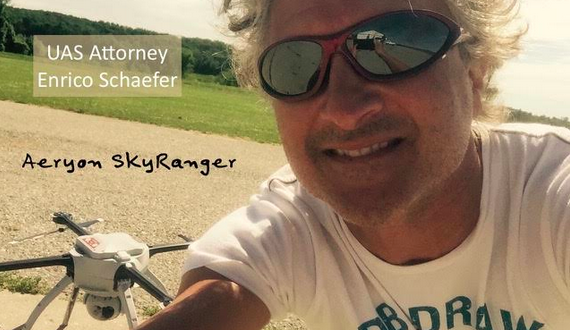Sponsored post from DroneLaw.Pro
Whether you are an established drone service company, or a newcomer, there is something about the beginning of a new year which inspires optimism. There is every reason to believe that this optimism for drone pilots will pay off in 2017.
Here are five things you need to know for your Part 107 drone pilot business to succeed in 2017:
1. Find your market advantage.
Every drone service company brings its own unique business model and attributes to the market. There is a difference between learning to fly a drone, and running a successful drone business. It is critical to identify your particular market advantage.
Some Part 107 businesses have highly skilled pilots. Smooth flight paths, streamlined operations and interesting vantage points are easy for the best pilots, and hard for new pilots. Very few Part 107 pilots actively market flight skills as part of their advantage. Yet, piloting the UAV with skill can be a huge differentiator.
Other players in the industry have a background in photography and video production. They have the right eye to capture the right shot with the right lighting, and have post-production skills that many drone pilots simply don’t have. It is one thing to capture 22 minutes of video. It is another to turn that footage into something special for the customer. If your post-production skills are strong, you have a big advantage over pilots who only have a basic understanding of Adobe Photoshop or Premier Pro.
As many Part 107 companies have discovered, finding customers that are willing to pay market rates for professional drone services can be challenging. Many of our clients are established non-UAS companies with an existing large customer base and are adding drone services to their existing offerings. These companies have a significant advantage. They already have revenue coming through the door, staff and infrastructure. They can offer drone services in a calculated and thoughtful way to their current customers, leveraging their existing relationships.
Other drone services companies have unique technology and software to offer customers, or have invested in more expensive equipment and payloads. We are already seeing the drone market starting to divide into market niches, with companies specializing in agriculture, infrastructure inspection, movie and film, construction, and real estate. Leveraging innovative technology can be a significant market advantage.
The first order of business for any drone service company is to find it’s market advantage and exploit it. What is your advantage?
2. Be patient but not complacent.
 Many people in the drone industry have been appropriately frustrated by the slow adoption of regulations by the FAA, and the slow implementation of the Part 107 Regulations, especially waivers and airspace authorizations. It is critical for drone pilots to understand that all new and emerging regulated technology go through a long period of regulatory change, updated interpretations and enforcement attitudes. Drone service providers need to be nimble in order to survive. While many aspiring drone businesses have already abandoned their dream, those who stick it out will be rewarded.
Many people in the drone industry have been appropriately frustrated by the slow adoption of regulations by the FAA, and the slow implementation of the Part 107 Regulations, especially waivers and airspace authorizations. It is critical for drone pilots to understand that all new and emerging regulated technology go through a long period of regulatory change, updated interpretations and enforcement attitudes. Drone service providers need to be nimble in order to survive. While many aspiring drone businesses have already abandoned their dream, those who stick it out will be rewarded.
The real opportunities for Part 107 operations are beginning to take shape. Part 107 is just the beginning. The drone market is just starting to take shape. Find the opportunity, irrespective of the obvious frustrations, and exploit them. 2017 will be the year that more customers not only begin to understand drones, but trust professional drone service providers to deliver. Being patient, but not complacent, will allow you to build a foundation for your drone service company.
3. ‘Perseverance’ is the number one differentiator of most successful entrepreneurs.
I have been practicing law for over twenty-five years and worked with thousands of different start-up companies in the regulated technology space. After listening to thousands of “pitches” from entrepreneurs, you might think it would be easy to identify those ideas that will succeed. But it is extremely difficult to predict success because the number one differentiator is the person pitching the idea.
Some of the craziest ideas that ever walked through my office door have become multi-million dollar companies. The number one differentiator is the perseverance required to overcome the hurdles. Surround yourself with people who display ‘perseverance’ as a fundamental character trait and you will be rewarded.
4. 2017 will become the year that professionalism becomes an industry priority.
If you have spent any amount of time on the internet, in forums, Facebook groups, or following Twitter, you see the division between drone pilots who don’t care about the regulations and those who, despite their frustrations with the FAA, embrace Part 107 and industry standards beyond Part 107. You also see the two camps battling online over the importance of regulatory compliance, and how to deal with the frustration of a very slow FAA UAV integration.
Rest assured. The industry will continue to become less tolerant of those flaunting Part 107 in 2017. The drone industry is growing up. Customers are starting to realize the importance of hiring professional operators not only for quality services, but to reduce their own liability risk. The industry knows that an educated customer base is a key market barrier. As customers become more knowledgeable about regulatory compliance, insurance and liability risk, they will feel more comfortable hiring drone service providers and help establish the market. Drone pilots are on the front line of educating customers about the return on investment, FAA regulations, compliance and industry standards. Being a “professional” drone pilot is a key market differentiator.
5. Getting involved will establish credibility.
In 2013 and 2014, the drone space was an insiders’ game. There have been industry players, experts and others who have been pushing the FAA towards UAV integration into the NAS for many years. In 2015, the Section 333 exemption process expanded the community of drone enthusiast, pilots, and aspiring entrepreneurs. This trend continued in 2016 with the partial implementation of Part 107. As of January 2017, over 25,000 remote pilot applications have been processed through IACRA and over 37,000 drones have been registered for commercial use. While the insiders will always claim superior street credibility, often because they don’t want to have to compete, there is one overwhelming fundamental truth to new and emerging regulating technology. The market size and market demand expand as a result of the growth and innovation that comes next. The drone pilots and operators who are entering the market right now are the ones who can make the biggest difference. Quite simply, it’s a numbers game.
In order for the market to develop there has to be enough drone operators and service providers to educate customers and create trust in the market. And while many of the newbies may not be world-class drone pilots (yet), they often bring new things to the market that the old guard can’t provide. It is the newer people in the industry who can have the greatest impact on growth; but this assumes those entering the market in 2016 and thereafter are willing to get involved in industry groups, educate municipalities on issues such as implied preemption, and work with their State legislatures to enact legislation devoted to integrating drones, rather than limiting use. Perhaps the biggest market differentiator will be a drone pilot’s reputation in the community. Smart drone entrepreneurs will not hesitate to get involved because of the business advantage in doing so.
Hopefully, the old guard will realize that being the ‘gatekeeper’ not only means protecting the space, but educating and incentivizing all pilots to work towards industry growth together. At this point, competition and supply-side growth of professional drone service companies can help create a much bigger market for everyone.
2017 is shaping up to be the most pivotal year for the drone industry to date. Good luck and fly safe. Remember, an updraft lifts all drones.
 Unmanned Aerial Vehicle The latest drone news
Unmanned Aerial Vehicle The latest drone news




